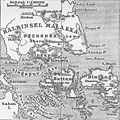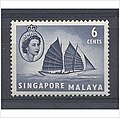Portal:Singapore
.jpg/330px-2005_Singapore_(30849229036).jpg) Map of Singapore Singapore, officially the Republic of Singapore, is an island country and city-state in Southeast Asia. The country's territory comprises one main island, 63 satellite islands and islets, and one outlying islet. It is about one degree of latitude (137 kilometres or 85 miles) north of the equator, off the southern tip of the Malay Peninsula, bordering the Strait of Malacca to the west, the Singapore Strait to the south along with the Riau Islands in Indonesia, the South China Sea to the east, and the Straits of Johor along with the State of Johor in Malaysia to the north.
In its early history, Singapore was a maritime emporium known as Temasek; subsequently, it was part of a major constituent part of several successive thalassocratic empires. Its contemporary era began in 1819, when Stamford Raffles established Singapore as an entrepôt trading post of the British Empire. In 1867, Singapore came under the direct control of Britain as part of the Straits Settlements. During World War II, Singapore was occupied by Japan in 1942 and returned to British control as a Crown colony following Japan's surrender in 1945. Singapore gained self-governance in 1959 and, in 1963, became part of the new federation of Malaysia, alongside Malaya, North Borneo, and Sarawak. Ideological differences led to Singapore's expulsion from the federation two years later; Singapore became an independent sovereign country in 1965. After early years of turbulence and despite lacking natural resources and a hinterland, the nation rapidly developed to become one of the Four Asian Tigers. As a highly developed country, it has the highest PPP-adjusted GDP per capita in the world. It is also identified as a tax haven. Singapore is the only country in Asia with a AAA sovereign credit rating from all major rating agencies. It is a major aviation, financial, and maritime shipping hub and has consistently been ranked as one of the most expensive cities to live in for expatriates and foreign workers. Singapore ranks highly in key social indicators: education, healthcare, quality of life, personal safety, infrastructure, and housing, with a home-ownership rate of 88 percent. Singaporeans enjoy one of the longest life expectancies, fastest Internet connection speeds, lowest infant mortality rates, and lowest levels of corruption in the world. It has the third highest population density of any country, although there are numerous green and recreational spaces as a result of urban planning. With a multicultural population and in recognition of the cultural identities of the major ethnic groups within the nation, Singapore has four official languages: English, Malay, Mandarin, and Tamil. English is the common language, with exclusive use in numerous public services. Multi-racialism is enshrined in the constitution and continues to shape national policies. Singapore is a parliamentary republic and its legal system is based on common law. While it is constitutionally a multi-party democracy where free elections are regularly held, it functions as a de facto one-party state, with the People's Action Party (PAP) maintaining continuous political dominance since 1959. The PAP's longstanding control has resulted in limited political pluralism and a highly centralised governance structure over national institutions. One of the five founding members of ASEAN, Singapore is also the headquarters of the Asia-Pacific Economic Cooperation Secretariat, the Pacific Economic Cooperation Council Secretariat, and is the host city of many international conferences and events. Singapore is also a member of the United Nations, the World Trade Organization, the East Asia Summit, the Non-Aligned Movement, and the Commonwealth of Nations. (Full article...)Selected article -Nicoll Highway MRT station is an underground Mass Rapid Transit (MRT) station on the Circle Line (CCL) in Singapore. Located in the Downtown Core underneath Republic Avenue near the Kallang River, the station serves commercial and residential developments along Nicoll Highway, such as the Golden Mile Complex and The Concourse. The station is operated by SMRT Trains. First announced as part of the Marina MRT line in 1999, the station was incorporated into Stage 1 of the CCL in 2001. During the construction, the tunnels linking to the original station site caved in along with the highway on 20 April 2004, killing four people. Following an investigation, which found human error and organisational failures as causes of the collapse, the station was relocated. Alongside the other stations on Stages 1 and 2 of the CCL, the station opened on 17 April 2010. (Full article...) Selected picture Little India is an ethnic neighbourhood found in Singapore that has Indian cultural elements. Little India lies to east of the Singapore River—across from Chinatown, located west of the river—and north of Kampong Glam. Both areas are part of the urban planning area of Rochor. Read more... General imagesThe following are images from various Singapore-related articles on Wikipedia.
Selected biography -Edwin Nadason Thumboo B.B.M. and Bar, PJG (born 22 November 1933) is a Singaporean poet and academic who is regarded as one of the pioneers of English literature in Singapore. Thumboo graduated in English from the University of Malaya in 1956. Although he applied for a position at the university, he was rejected as few locals held academic posts at that time. He therefore worked in the civil service for about nine years before finally joining the university, which was then renamed the University of Singapore, in 1966 following Singapore's independence. He received a Ph.D. from the university in 1970. Thumboo rose to the position of full professor in the Department of English Language and Literature, heading the department between 1977 and 1993. After the merger of the University of Singapore and Nanyang University in 1980 to form the National University of Singapore (NUS), he was the Dean of the Faculty of Arts and Social Sciences from 1980 to 1991, NUS's longest-serving dean of the Faculty of Arts and Social Sciences. Thumboo was the first Chairman and Director of the university's Centre for the Arts from 1993 to 2005, and continues to be associated with the university as an emeritus professor, a position he has held since retiring from full-time teaching in September 1997. (Full article...) Did you know (auto-generated)
In this month
More did you know -
Selected panoramaSungei Serangoon (Malay for Serangoon River; Chinese: 实龙岗河) is a river in the north-eastern part of Singapore. The 6-kilometre river starts as a canal near Tampines Road, and flows through Hougang, Sengkang, Punggol, Lorong Halus and Pasir Ris, before emptying into the Serangoon Harbour. The river is also known as the Serangoon Estuary. Singapore topicsRelated portalsSoutheast Asia Other Countries Tasks
CategoriesWikiprojectsAssociated WikimediaThe following Wikimedia Foundation sister projects provide more on this subject:
Discover Wikipedia using portals |




.jpg/120px-2016_Singapur%2C_Chinatown%2C_Świątynia_i_Muzeum_Relikwi_Zęba_Buddy_(04).jpg)






















_by_Lieutenant_Philip_Jackson.jpg/120px-Plan_of_the_Town_of_Singapore_(1822)_by_Lieutenant_Philip_Jackson.jpg)





.jpg/120px-Map_of_Singapore_(Baedeker%2C_1914).jpg)


%2C_St_Andrew%27s_Cathedral_--_2019_--_4534.jpg/120px-Singapore_(SG)%2C_St_Andrew%27s_Cathedral_--_2019_--_4534.jpg)

















